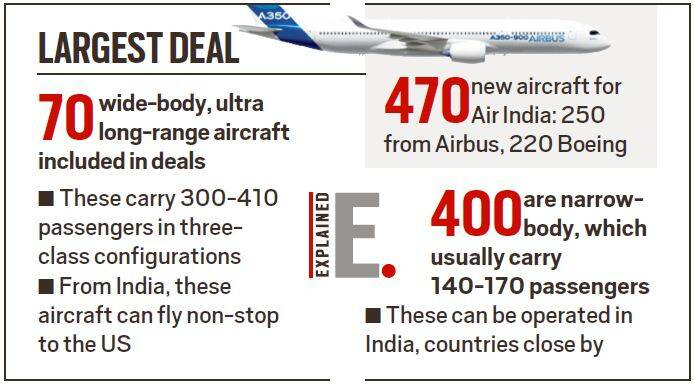Indian Economy
470 Airbus, Boeing Planes for Air India
- 16 Feb 2023
- 5 min read
For Prelims: National Civil Aviation Policy 2016, UDAN, UDAN 2.0, Airport Authority of India.
For Mains: Status of India's Aviation Sector, Recent Government Initiatives Related to Aviation Sector.
Why in News?
Air India has announced two major deals worth around USD 100 billion to buy 470 passenger planes from top aircraft manufacturers Airbus (with France) and Boeing (with United States).
What is the Significance of this Aircraft Deal for India?
- The deal reflects India’s aspirations to be a world leader in the aviation sector, which is projected to require over 2,000 aircraft in the next 15 years.
- This is the first aircraft order Air India has placed in 17 years and the first A350 aircraft will be delivered to Air India by the end of 2023.
- The deal is expected to make India the third-largest player in the aviation sector and create new opportunities in aerospace manufacturing under India’s ‘Make in India-Make for the World’ vision.
What is the Status of India's Aviation Sector?
- About:
- India's Civil Aviation is among the fastest-growing aviation markets globally and will be a major growth engine to make India a USD 5 trillion economy by 2024.
- The nation's aeroplane fleet is projected to quadruple in size to approximately 2500 aeroplanes by 2038.
- Recent Government Initiatives Related to Aviation Sector:
- National Civil Aviation Policy (NCAP) 2016:
- Through the NCAP 2016 the government plans to take flying to the masses by enhancing affordability and connectivity.
- It promotes ease of doing business, deregulation, simplified procedures, and e-governance.
- The Regional Connectivity Scheme or UDAN (‘Ude Desh ka Aam Nagrik’) is a vital component of NCAP 2016.
- Through the NCAP 2016 the government plans to take flying to the masses by enhancing affordability and connectivity.
- UDAN 2.0:
- The Scheme lays out the vision of improving value realisation through better integration and optimization of Agri-harvesting and air transportation and contributing to Agri-value chain sustainability, resilience under different and dynamic conditions.
- Monetising Assets through PPP Mode:
- The Centre has earmarked a total of 25 airports for asset monetisation over the years 2022 to 2025 under the National Monetization Pipeline.
- National Civil Aviation Policy (NCAP) 2016:
- Challenges:
- High Operating Costs: One of the major challenges for the Indian aviation sector is the high operating costs. This is due to a number of factors such as high fuel prices, airport charges, and taxes.
- Infrastructure Constraints: The Indian aviation sector also faces infrastructure constraints such as limited airport capacity, lack of modernised air traffic control systems, and inadequate ground handling facilities.
- Regulatory Framework: The Indian aviation sector also faces challenges related to the regulatory framework.
- The sector is heavily regulated, and airlines have to comply with a number of rules and regulations through different windows, which can be complex and time-consuming.
Way Forward
- Leveraging Technology: The Indian aviation sector can benefit from the use of modern technology to enhance efficiency and passenger experience.
- This includes the use of artificial intelligence, robotics, and big data analytics to improve operations, reduce costs, and enhance safety.
- Encouraging Sustainable Practices: The Indian aviation sector needs to adopt sustainable practices, including the use of alternative fuels and reducing carbon emissions, to mitigate the impact of aviation on the environment.
- Encouraging Regional Connectivity: The Indian government needs to encourage the development of regional airports to enhance connectivity to remote areas of the country.
- This would require developing a regional air transport network and incentivizing airlines to operate in these areas
UPSC Civil Services Examination, Previous Year Questions (PYQs)
Q. Examine the development of Airports in India through joint ventures under Public–Private Partnership (PPP) model. What are the challenges faced by the authorities in this regard? (2017)
Q. International civil aviation laws provide all countries complete and exclusive sovereignty over the airspace above their territory. What do you understand by ‘airspace’? What are the implications of these laws on the space above this airspace? Discuss the challenges which this poses and suggest ways to contain the threat. (2014)







